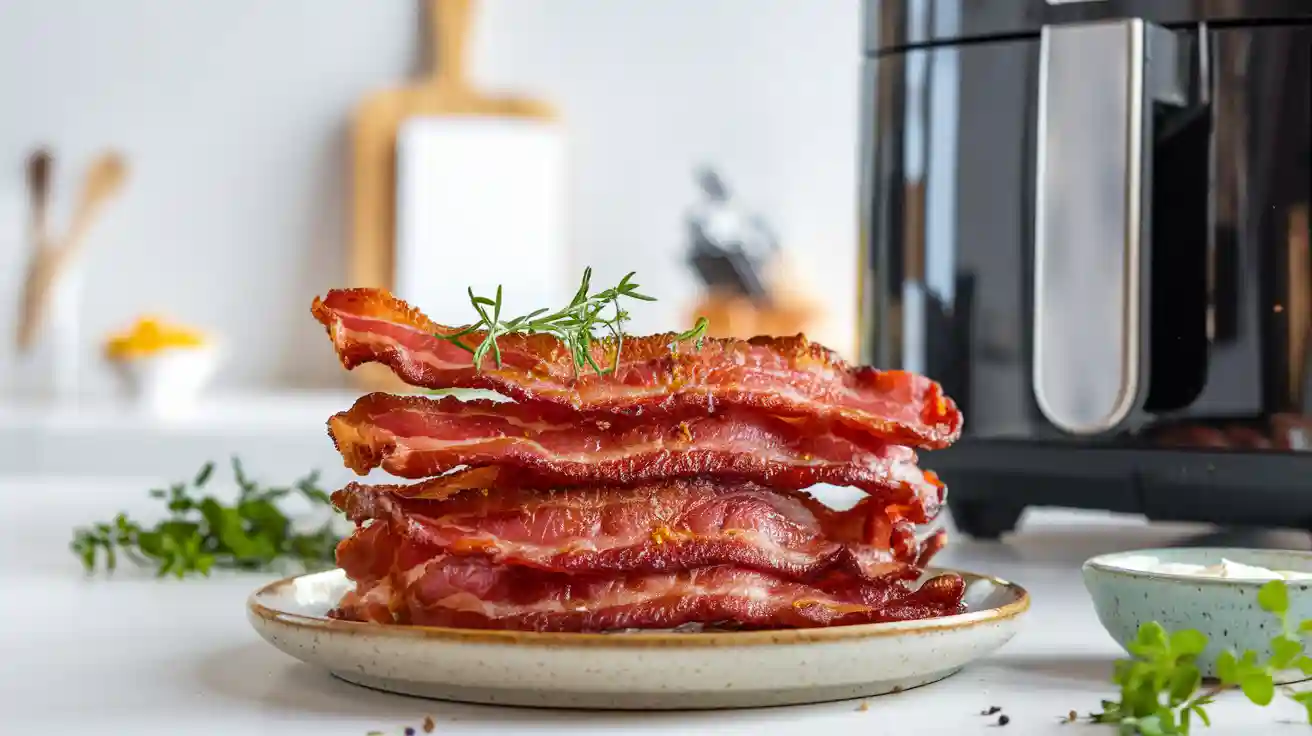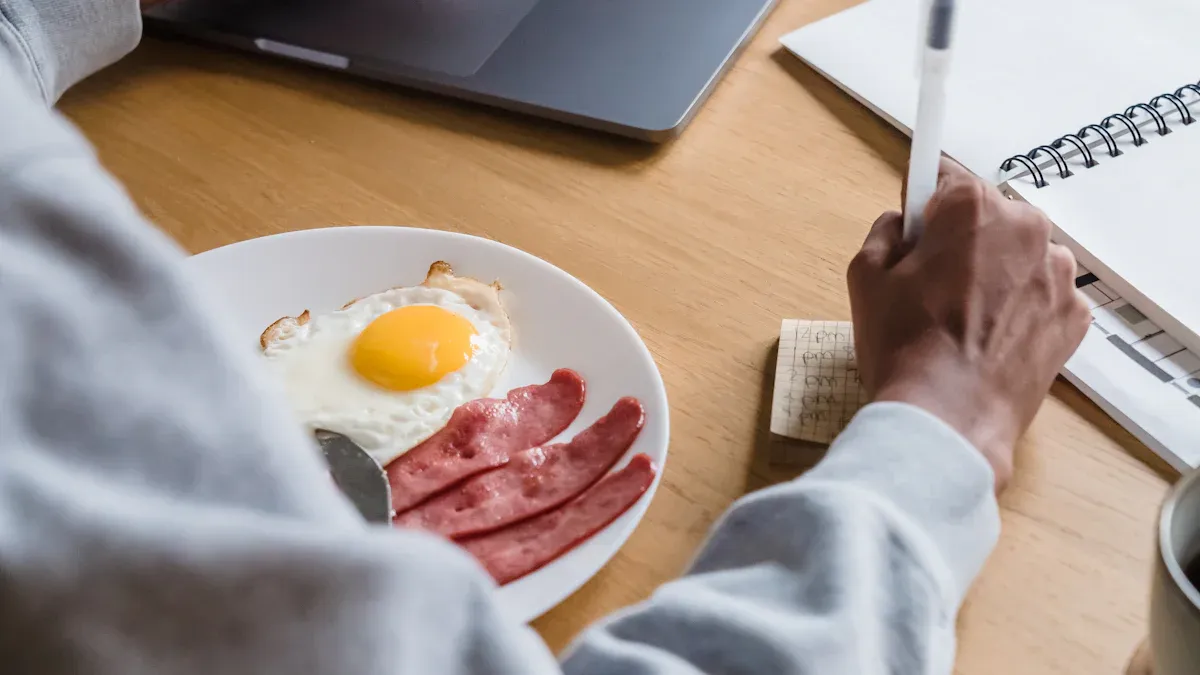
Perfectly cooked air fryer bacon is not just delicious—it’s a science. When you cook bacon in an air fryer, three factors determine the results: temperature, airflow, and grease control. For instance, setting the air fryer to 350ºF (175ºC) ensures the bacon cooks evenly. In just 10 minutes, you can enjoy tender-crisp air fryer bacon, or extend the time to 13 minutes for a crunchier texture. By understanding these principles, you can achieve crispy, golden perfection every time with your air fryer bacon.
The Best Way to Cook Bacon: Start with the Right Temperature
Why Temperature is Crucial for Air Fryer Bacon
Temperature plays a key role in achieving perfectly cooked bacon. When you set the right temperature, the air fryer’s convection technology circulates hot air evenly around the bacon. This ensures that every strip cooks consistently, with no soggy or burnt spots. Cooking at too low a temperature can result in chewy bacon, while excessively high heat risks burning the edges before the center is done.
Scientific studies also highlight the importance of temperature in bacon cooking. For example, acrylamide, a compound that contributes to browning and crispiness, begins forming at 250°F (121°C). However, temperatures above 500°F (260°C) can cause harmful chemical breakdowns. By choosing the right temperature, you can balance safety and flavor while maximizing crispiness.
The Ideal Temperature for Crispy Bacon
The best way to cook bacon in an air fryer starts with setting the temperature correctly. Experts recommend cooking bacon at 375°F for optimal results. This temperature allows the bacon to cook quickly while achieving a crispy texture. For regular-cut bacon, 8-10 minutes at 350°F (180°C) works well, delivering crispy strips with minimal grease. If you prefer extra-crispy bacon, you can increase the temperature slightly to 390°F and cook for about 7 minutes. Lower temperatures, such as 200°F, can also work but require much longer cooking times.
Adjusting for Thick or Thin-Cut Bacon
Not all bacon is created equal. Thick-cut bacon requires more time to cook than regular-cut bacon due to its density. For thick-cut bacon, aim for 12-14 minutes at 375°F to achieve a crispy texture. Regular-cut bacon, being thinner, cooks faster and typically needs only 8-10 minutes at the same temperature. Always check the bacon halfway through cooking to ensure it doesn’t overcook. Adjusting the time based on the thickness of the bacon ensures you get the perfect balance of crispiness and flavor.
Air Fryer Bacon Success: Arrange for Optimal Airflow

The Role of Air Circulation in Cooking Bacon
Air circulation is the secret to evenly cooked air fryer bacon. The air fryer uses a fan to circulate hot air rapidly, creating a convection effect. This process ensures that every strip of bacon cooks evenly without needing to flip it. The precise temperature control and consistent heat distribution also contribute to achieving crispy results. Whether you’re cooking thick-cut bacon or regular-cut bacon, the airflow guarantees that each piece gets the same level of heat exposure, preventing soggy or burnt spots.
Tip: To maximize air circulation, avoid blocking the air fryer’s vents. Proper airflow is essential for the bacon cooking method to work effectively.
Avoiding Overlap and Crowding
Crowding the air fryer basket can lead to unevenly cooked bacon. When bacon strips overlap, the hot air cannot reach all surfaces, leaving some parts undercooked. To avoid this, arrange the bacon in a single layer with space between each strip. This allows the hot air to circulate freely around the bacon, ensuring consistent crispiness. For larger batches, cook in multiple rounds or pause halfway through to rotate the strips.
Note: Overlapping bacon strips may seem convenient, but it compromises the quality of your air fryer bacon. Always prioritize spacing for the best results.
Tips for Cooking Larger Batches
Cooking larger portions of bacon in an air fryer requires careful planning. If you’re preparing thick-cut bacon or regular-cut bacon for a crowd, divide the strips into smaller batches. This prevents overcrowding and ensures even cooking. Alternatively, pause the cooking process halfway through and rearrange the strips to expose all sides to the circulating air. For thick-cut bacon, consider increasing the cooking time slightly to account for its density.
Pro Tip: Use a rack or tray designed for air fryers to cook multiple layers of bacon simultaneously. This method maintains airflow while increasing capacity.
Manage Grease for the Best Results
Why Grease Management Matters
Managing grease is essential for achieving crispy bacon in your air fryer. Excess grease can pool around the bacon, making it soggy instead of crisp. The air fryer’s design helps by allowing grease to drain away during cooking. This process enhances the texture and ensures your bacon remains light and flavorful.
To maintain grease quality, always cook bacon in a single layer. Overlapping strips trap grease, which affects the crispiness. For thick-cut bacon, this step becomes even more critical due to its higher fat content. You can also place a slice of bread in the air fryer drawer to absorb grease drippings. This simple trick keeps the cooking environment cleaner and helps maintain the bacon’s texture.
Using Foil or Parchment Paper Safely
Foil or parchment paper can simplify cleanup, but you must use them correctly. Avoid covering the entire basket or blocking the air fryer’s vents. Proper airflow is crucial for the bacon cooking method to work effectively.
When using foil, fold the edges to create a shallow tray that catches grease without obstructing air circulation. For parchment paper, choose air fryer-safe options that can withstand high temperatures. These materials work well for both thick-cut and regular-cut bacon, ensuring even cooking and easy cleanup.
Tip: Always check your air fryer’s manual to confirm whether foil or parchment paper is safe to use.
Draining Grease for Extra Crispiness
Draining grease during cooking can take your air fried bacon to the next level. Pause the cooking process halfway through and carefully drain the grease from the drawer. This step prevents the bacon from sitting in its own fat, which can compromise its texture.
For thick-cut bacon, draining grease is especially important. Its higher fat content produces more drippings, which can lead to uneven cooking. Regular-cut bacon benefits from this step as well, ensuring every strip turns out crispy and golden.
Once the bacon finishes cooking, transfer it to a plate lined with paper towels. This final step removes any remaining grease, leaving you with perfectly crispy bacon that’s ready to enjoy.
Mastering how to cook bacon in an air fryer comes down to three science-based secrets: temperature, airflow, and grease management. These tips ensure your bacon turns out crispy and evenly cooked every time. Whether you’re preparing thick-cut or regular-cut bacon, this bacon cooking method delivers consistent results. Try these techniques today and enjoy perfect air fryer bacon with minimal mess!
FAQ
How do you prevent bacon from sticking to the air fryer basket?
Use a light spray of cooking oil on the basket before placing the bacon. This prevents sticking and makes cleanup easier.
Can you cook frozen bacon in an air fryer?
Yes, you can. Add 2-3 extra minutes to the cooking time. Separate the strips once they start thawing for even cooking.
Is it safe to cook bacon in an air fryer every day?
Yes, it’s safe. However, clean the air fryer regularly to prevent grease buildup and maintain optimal performance.


